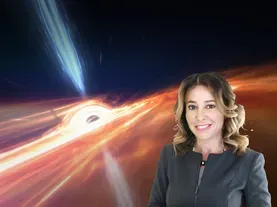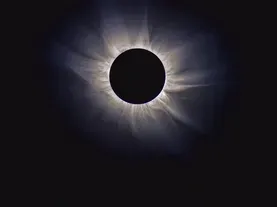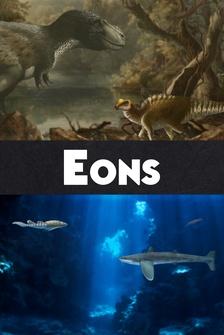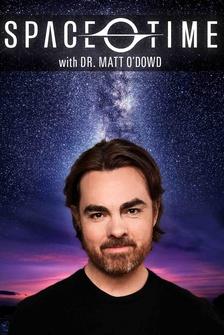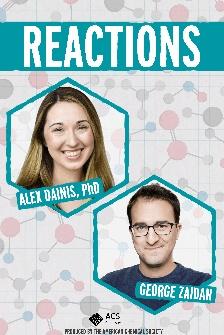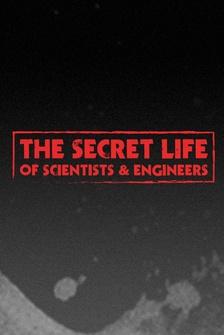(gentle chiming music) - [Narrator] A lot has changed in the last 50 years, especially in our understanding of the cosmos.
- The last 50 years, I think, have been the most exciting ever.
Our entire understanding of the universe just turned upside down.
- [Narrator] Welcome to the dark universe, where powerful, yet invisible dark matter holds cosmic sway, shaping even the very galaxy we call home.
- Dark matter is four times or five times more abundant than the stuff we can see.
It is fundamentally disturbing.
(dramatic music) - [Narrator] But we're on the hunt.
- We're entering discovery territory.
- [Narrator] And the darkness doesn't end there.
A ghostly form of dark energy dominates the universe, driving its expansion, maybe even choosing its fate.
- I don't think we possibly could have grasped just how profound it was.
- This is a huge discovery.
- [Narrator] It remains a total enigma.
- We have absolutely no idea what dark energy is.
- [Narrator] The more we've learned about our universe, the stranger it becomes.
- This is something that can't just be wished away.
- That's where to look for the next breakthrough.
- It's potentially Nobel Prize winning.
- [Narrator] "Decoding the Universe," right now on NOVA.
(dramatic music) (dramatic music continues) (dramatic music continues) ♪ ♪ NARRATOR: September 5, 1977.
ARCHIVAL: Three, two, one... ...and we have lift-off!
NARRATOR: A Titan-Centaur rocket carrying the space probe, Voyager 1, launches from Cape Canaveral.
REPORTER: The Voyager spacecraft to extend man's senses farther into the solar system than ever before.
NARRATOR: The Voyager program would become NASA's longest mission to date.
KAISER: I absolutely remember the coverage.
I remember watching the launch-- it was really exciting.
I had no sense of the scale of where that thing was headed, to where no human-built things had ever gone before.
NARRATOR: In 1979, Voyager 1 flies past Jupiter.
(applause) ♪ ♪ About a year-and-a-half later, Saturn.
♪ ♪ Though it will continue on its journey, in 1990, it sends its last images.
Looking back at the solar system... ...Earth is just a tiny speck.
In Carl Sagan's words, "a pale, blue dot."
KÖNIG: The Pale Blue dot-- it's telling us, we're incredibly small.
At the same time, it also tells us that we've gone incredibly far.
I mean in cosmology, we're looking, we're looking at supernovae.
We're looking at other galaxies.
We're looking at the beginning of the universe.
But there's so much more that needs to be done.
NARRATOR: During Voyager 1's nearly 50-year-long mission, our scientific understanding of the universe has grown immensely... ...and even radically changed.
The last 50 years, I think, have been the most exciting ever.
Our entire understanding of the universe has changed, it's just turned upside down.
Over the past 50 years, there's really been several revolutions in our understanding of the universe.
We can both be proud of how far we've come, but also be excited about how much we don't know.
♪ ♪ NARRATOR: Looking back, the discoveries of the last 50 years are remarkable.
In the 1970s, Luke Skywalker's home, Tatooine, was as close as we got to seeing an alien planet.
In the 1970s, we knew of precisely zero planets outside of our solar system.
And in the decades since then, we've moved that number up into the thousands.
SUSAN MULLALLY: We've discovered planets are incredibly common in our galaxy.
There are more planets out there than there are stars.
So go out and look at the night sky.
For every one of those stars, there are probably several planets.
NARRATOR: And in recent decades, we've also learned... ...our Milky Way galaxy isn't even one in a million.
A fact made evident by this astonishing series of images taken by the Hubble Space telescope in 1995.
Just about every single bright point is a galaxy.
Scientists now think galaxies in the universe may number in the trillions.
KÖNIG: The Hubble pictures tell us that the universe is the same everywhere.
It's also a reminder that we are definitely not the center of the universe.
NARRATOR: One of the most shocking discoveries of the last 50 years, was made in our own cosmic backyard.
In 1998, astrophysicist Andrea Ghez and her team surprised the world when they revealed evidence of a super massive black hole at the center of our own Milky Way.
GHEZ: From watching stars orbit the center of the galaxy, the mass that we infer is four million times the mass of the sun.
That is the proof of a black hole.
NARRATOR: Astronomers now believe that just about every galaxy has one.
CLIFFORD JOHNSON: Black holes are crucial to how we understand galaxies.
That is a huge new role for black holes and our understanding of them.
NARRATOR: But perhaps the biggest discovery of the last 50 years is just how much we don't know.
Somehow we've missed much, much more than we've discovered.
There is some new form of matter out in the universe, and it is four times or five times more abundant than the stuff we can see.
And so that is the shocking truth of dark matter.
NARRATOR: Dark matter-- only accepted as "real" during the last 50 years, and now, one of the biggest mysteries in the history of science.
So far, its effects have only been detected on the cosmic stage.
But understanding it, may hold the key to the very structure of the universe.
My mum is always like, you know, "Why do we have to care about dark matter?"
And, and the truth is that without dark matter, we simply wouldn't exist.
KAISER: Dark matter is, in part, the story of why and how we're here.
NARRATOR: And yet, in recent decades, scientists have uncovered evidence of something that, today, is even more powerful than dark matter.
I just, I don't think we possibly could have grasped just how profound and how much it would change our view of the universe.
It would be like as though you had only ever experienced land, and then one day, you discover the oceans.
NARRATOR: It's called "dark energy."
Scientists now believe it's the most powerful force in the universe, expanding its very fabric, pushing galaxies apart, and it may even be driving the universe's ultimate fate.
But it remains an enigma.
We have absolutely no idea what dark energy is to this day.
NARRATOR: How did our vision of the universe get completely overturned in just a few decades?
And what new surprises might lie just over the horizon?
JOHN JOHNSON: The past 50 years of astrophysics has shown that the universe is extraordinarily creative in what is out there.
And it's very determined to consistently subvert our expectations.
BAHCALL: We are so struggling to figure out the nature of our cosmos.
And that's very humbling, very humbling, yet very empowering.
It's a, it's a strange combination of the two things together.
♪ ♪ NARRATOR: Since Voyager 1 left Earth, astrophysicists and astronomers have overtaken the intrepid probe... ...reaching farther and farther out into space to gather data written across vast expanses of time, and on colossal scales.
In stars, nebulas, supernovas, distant galaxies and galaxy clusters.
VERA RUBIN: There's the galaxy.
We're at the object.
NARRATOR: And in the 1970s, it was just such data, meticulous observations gathered by an astronomer, that forced scientists to confront the idea of dark matter.
The astronomer's name was Vera Rubin.
You'll get a guide star, I'll set up for the observation.
♪ ♪ NARRATOR: Rubin was born in 1928 in Philadelphia.
From a young age, she was hooked on the stars.
RUBIN: By about age 12, I would prefer to stay up and watch the stars than going to sleep.
There was just nothing as interesting in my life as watching stars every night.
I knew I wanted to be an astronomer.
NARRATOR: In 1963, Vera Rubin traveled here, to the Kitt Peak National Observatory in the Schuk Toak District on the Tohono O'odham Nation, 56 miles southwest of Tucson, Arizona.
Despite having advanced degrees for over a decade, Rubin had never been able to collect her own data.
Astronomy had few women, and many observatories weren't welcoming.
Some officially did not allow women.
But the National Observatory at Kitt Peak had just recently opened and accepted her application.
She would return to Kitt Peak several times over her career as she began to focus more on galaxies.
So Vera Rubin really was what I would call a true observational astronomer.
She loved to go to the telescope, do the observation, take it to her office and analyze them, and try to see what it told her about the galaxies.
NARRATOR: Today, in more ways than one, Stanford Cosmologist Risa Wechsler follows in Rubin's footsteps.
So this instrument behind me is the 84-inch telescope at Kitt Peak.
Vera Rubin started using it in 1968 when she started making measurements of the Andromeda Galaxy, and looking at how different regions in Andromeda were moving.
NARRATOR: Rubin wanted to check a common assumption among astronomers about galaxies.
The presumption was that stars near the center of a galaxy would be orbiting very rapidly, and stars at the outside would be going very slowly.
NARRATOR: That idea came from the way the planets in our solar system orbit our massive sun.
Because the attractive force of the sun's gravity falls off with distance, the farther away from the sun a planet orbits, the slower its orbital speed.
Astronomers assumed the stars in a galaxy would behave the same way.
Like the sun in our solar system, the bright, star-packed center of a galaxy appeared to hold most of the galaxy's mass.
So a galaxy's orbiting stars should act like the planets, with orbits slowing toward the galaxy's outer edges.
But no one had done the work to know for sure.
Partly, it was a technical issue, which Rubin solved by teaming up with instrument maker Kent Ford.
He had developed a device that enhanced a telescope's light sensitivity, making it possible to finally see the faint stars on the far edges of galaxies.
And what they saw was surprising.
WECHSLER: They found that the regions of Andromeda that were quite far out were still rotating quite fast, faster than you would have expected by the amount of light that was there.
NARRATOR: It was a strange observation.
What was keeping those fast-moving outer stars from flying off?
During the 1970s, Rubin and Ford, along with other astronomers, gathered more and more data from more and more galaxies.
Almost none showed the speed of orbiting stars dropping as had been expected.
Still, it would take years for the astronomy community to accept the astonishing explanation that Rubin and others proposed; that there was a vast amount of hidden matter surrounding each galaxy, gravitationally holding it together.
Aside from that effect, it was undetectable.
AMON: If you didn't have some invisible mass in the galaxy, the stars would not be bound in this, in this orbit.
They would fly out.
RUBIN: We now know that in every galaxy we study, the stars at very large distances are orbiting with very high velocities.
And that tells us that there is a lot of matter at very large distances from the center.
So we see a lot of matter where we don't see very much light.
And that has led to the concept of dark matter.
NARRATOR: Dark matter.
Astronomer Fritz Zwicky had proposed the name in the 1930s to describe an "unseen mass" to explain some puzzling observations of a nearby galaxy cluster.
But the idea had been largely ignored until Rubin and Ford came along.
Today, scientists estimate there is five times more dark matter than ordinary matter in the universe.
It's arranged in a vast web-like structure of filaments and nodes.
In the early universe, those nodes, through gravity, attracted regular matter which eventually evolved into galaxies.
But what is dark matter?
PEREZ: Over the last 50 years, this question has become a guiding question for huge swaths of the physics community.
We've had some of the smartest people in the world banging heads against the wall for decades.
This is a really hard problem.
NARRATOR: There aren't many clues.
Aside from its gravitational effect, dark matter appears to interact very little with normal matter, and can pass right through it.
It also emits no electromagnetic radiation, no light.
There are forms of matter that simply don't glow like stars do, but actually they're also not responding to light.
So they are invisible, except through their gravitational force.
It probably is something quite exotic.
It isn't any of the ordinary stuff.
NARRATOR: So who are the suspects for dark matter?
There are the MACHOs; the Massive Compact Halo Objects, like primordial black holes.
CLIFFORD JOHNSON: Black holes that go back to the very earliest eras of the universe could be a major component of dark matter.
NARRATOR: For a primordial black hole to fit the bill as dark matter, it would have about the mass of an asteroid, and be about the size of an atom.
And there are axions-- minuscule particles theorized by physicists.
An axion, if it exists, interacts only very infrequently with light, and it does have some mass, so it could be dark matter.
NARRATOR: But the suspects who garnered early fans were the WIMPs; Weakly Interacting Massive Particles.
The search for WIMPs leads here, to the Black Hills of South Dakota.
Native Americans have long considered the area sacred, and the Fort Laramie Treaty of 1868 included the Black Hills in the Great Sioux Reservation.
But just a few years later, the discovery of gold and an influx of miners, led to the Great Sioux War of 1876.
The U.S. government seized the area, and forcibly relocated its Sioux inhabitants.
The dispute over the broken treaty remains unresolved.
♪ ♪ Today, in the town of Lead, a retired gold mine houses the Sanford Underground Research Facility.
(elevator rumbling) (rattling) Chamkaur Ghag, a professor at University College London, is a founding member of a team of researchers drawn from universities around the world that's on the hunt for dark matter, in the form of WIMPs.
To get down a mile, um, takes a bit of time.
NARRATOR: Why build a dark matter WIMP detector so far underground?
GHAG: So a mile of rock above us here in the Black Hills of South Dakota that shield us from cosmic radiation, that is bombarding us all the time.
And being underground, we're able to reduce that by factors of millions.
So this experiment up on the on the surface just wouldn't be able to run at all.
It's just far too sensitive.
WORKER: And then go ahead, hop on the train.
Ready?
Yep.
NARRATOR: After the ten minute ride down, it's on to a battery-powered locomotive, followed by a brief hike to get to the cavern that holds the lab of the LUX-ZEPLIN or LZ detector experiment.
GHAG: The core of the experiment is xenon, it's liquid xenon.
It's xenon gas that's been condensed.
And we've got to keep that clean, and we've got to keep it cold, and so much of what we'll see around here is all for that, really.
NARRATOR: Here is the main experiment.
At its center is a container of seven metric tons of very pure, cooled liquid xenon.
The concept is straightforward; the cooled xenon is extremely sensitive.
Even just a single collision between one of the theoretical WIMPs and the nucleus of a xenon atom would cause the atom to collide with others, emitting a flash of ultraviolet light, which would be picked up by the detectors at the top and bottom of the tank.
The interaction would also liberate electrons.
They'd drift up to the top, and emit an even bigger flash.
GHAG: So we get two flashes of light here, and based on how these two signals look relative to one another, we can tell whether this was background radiation, or if this was a dark matter particle that came in and hit the nucleus of a xenon atom.
NARRATOR: LZ isn't the only experiment using cooled xenon, but it now leads the pack in sensitivity.
It's the frontrunner now.
And so, we're entering discovery territory.
NARRATOR: Direct dark matter detection experiments go back to the 1980s.
Xenon-based experiments, similar in design to LZ, to the 2000s.
So far, all the experiments combined have detected nothing.
But the process constantly narrows down what dark matter could possibly be.
And currently, LZ has time on its side.
The plan is to accrue a total of three years' worth of data.
GHAG: Hopefully, there'll be a direct detection and we'll start to understand the nature of it.
It could be that dark matter isn't a simple one-size-fits-all WIMP.
It could be that there's multiple different types of dark matter, different species of the stuff, and we start to understand the dark sector as more of a zoo.
♪ ♪ I'm deeply interested in trying to make some headway into the unknown.
So the bigger the unknown, the better for me.
So yeah, dark matter being 85% of the mass of the universe, that we have no real clue about what this stuff is.
But it is profoundly important.
♪ ♪ NARRATOR: It's been a striking transformation.
In the past 50 years, thanks to Vera Rubin and others, dark matter has become an essential scientific building block at the foundation of our understanding of the universe.
There is no way out of dark matter.
If you believe in general relativity and Newton's law, if you believe in that, no way out of dark matter; you have to have dark matter.
NARRATOR: In 1998, as Voyager 1 traveled to the far reaches of our solar system, it surpassed the record of a previous space probe, Pioneer 10, as the most distant human-made object.
It was 6.5 billion miles from Earth.
1998 was also the year of one of the greatest discoveries in the history of science.
What seemed to be a force that literally creates new space out of nothing.
Today's issue of the journal "Science" reports new information about the evolution of the universe.
A lead author of one of the studies was cosmologist Adam Riess.
Thanks for being with us.
Thank you.
Why did some scientists react with what one called "amazement and horror" to these conclusions?
Why was it such a shock to them?
So we were hoping we'd find a more simple explanation, something mundane, but...
But instead, you found a new force in the universe?
Well, it would appear that way.
♪ ♪ NARRATOR: One of Baltimore's hidden gems is the George Peabody Library at Johns Hopkins University.
It has been called "one of the most beautiful library spaces in the world."
These five tiers hold 300,000 volumes, including astronomical works written over the centuries, that try to answer a question that has troubled humankind perhaps always... ...when we look up at the night sky, what is it we are seeing?
And has it been there forever?
♪ ♪ Adam Riess, an astrophysicist from Johns Hopkins, played a key role in formulating the current scientific answer to that question.
RIESS: Wow.
This is really the original earth-centric model.
NARRATOR: Like many in astronomy, he has a deep appreciation that he stands upon the shoulders of giants.
This is really my favorite here.
Copernicus puts the sun in the right place.
This is progress in science.
NARRATOR: But Riess has also added to our understanding of cosmology... (applause) ...sharing a Nobel Prize in 2011 with Saul Perlmutter and Brian P. Schmidt, for a discovery that profoundly changed our view of the universe.
RIESS: Here's somebody after my own heart taking the observations, Tycho Brahe.
NARRATOR: Each of these influential thinkers from prior to the 20th century have contributed to our understanding of "the heavens."
♪ ♪ And here comes Isaac Newton, who really develops the mathematics.
And he really lays out how gravity works.
NARRATOR: But they all shared something in common-- whatever the heavens were, they seemed eternal.
Earth may be at the center surrounded by celestial spheres, or the sun may be at the center with the planets orbiting it.
Comets may come into view and disappear, but all of these took place on a gigantic but static stage.
♪ ♪ Even Albert Einstein initially agreed.
By the early 20th century, he had already revolutionized the Newtonian view of the world, by connecting space and time into one concept he called space-time, and then theorizing that gravity was the warping of that space-time fabric by mass and energy.
In 1917, he applied his new ideas to the entire universe.
But he already had a final result in mind, the one generally accepted by astronomers.
Einstein's universe would be a largely static and unchanging one, though gravity posed a problem.
Einstein had kind of a puzzle in his mind, because if the universe was static, and yet all the matter in it was attractive, gravity would pull things together.
How did it stay static?
What kept it static?
And he made a remarkable discovery.
In his theory of general relativity, the gravity of matter can be attractive, but that the gravity of empty space could be repulsive.
He called this the cosmological constant, and he thought it was a possibility that these two kinds of gravities-- the attractive and the repulsive kind from two different kinds of aspects of space-- were causing this kind of stalemate.
♪ ♪ NARRATOR: Einstein's solution didn't stand for long.
And here, at the Mount Wilson Observatory outside of Los Angeles, is where astronomers gathered some of the data that led to its fall.
♪ ♪ These days, you may be lucky enough to hear a woodwind quintet playing in one of its storied domes-- the acoustics are exceptional.
(quintet performing) And it is an inspiring place for theoretical physicist and graphic nonfiction author Clifford Johnson to let his mind explore.
In the 1920s, this observatory produced two of the most important discoveries about the nature of the universe... (quintet performing) ...both by astronomer Edwin Hubble-- the same Hubble the famous space telescope is named for.
Hubble changes our entire view of what the universe is and how vast it is.
NARRATOR: At the time, a debate raged in astronomy: was the Milky Way the entire universe?
Or was there more to the story?
In 1925, Hubble settled the issue by proving that the Andromeda Nebula existed outside of the Milky Way.
It, along with other distant nebulas, were renamed "galaxies."
♪ ♪ DE SWART: The whole notion of a "galaxy" started to become a thing only in the mid-1920s.
People started immediately get interested in what these things are.
NARRATOR: Especially Edwin Hubble.
He began measuring the distance from Earth to various galaxies, and when he combined his work with that of other astronomers, he discovered something deeply mysterious.
It had to do with the Doppler effect.
(distorted pitch shifting) We typically think of the Doppler effect in terms of sound.
A siren coming toward you has a higher pitch, because the sound waves catch up to each other and become compressed.
A siren heading away from you sounds lower, because the sound waves stretch out.
♪ ♪ A similar thing happens with light waves-- if the source of light is headed toward the observer, the light it emits will be shifted toward blue.
If the source is moving away, the light is shifted toward red.
(film reel ticking) In fact, astronomers working parallel to Hubble encountered exactly that.
The light coming from almost every galaxy they observed was shifted toward red, indicating the galaxies were moving away from Earth.
And when Hubble checked the redshifts against his own distance measurements, he discovered not only were the galaxies racing away from us, but the ones farther away were racing away faster!
What did that mean?
CLIFFORD JOHNSON: Given that we're not in a special place in the universe, we're not at the center of the universe, the conclusion is, is that the whole universe is expanding.
Everything is moving away from everything else.
This is another huge discovery about the nature of our universe.
♪ ♪ NARRATOR: Some astronomers, like Belgian cosmologist and Catholic priest Georges Lemaître, were already exploring the implications of an expanding universe.
If you rewind the expansion, like a film, where does the universe "start"?
Does it have a beginning?
♪ ♪ The idea is that there was some earlier phase in the universe where everything was much closer together.
Some very dense early phase of the universe.
And something happened to begin to push things apart.
(explosion booming) That line of thinking led to the theory labeled by its detractors as "The Big Bang."
♪ ♪ (explosion echoing) It wasn't until the mid-1960s that observational evidence quieted the Big Bang critics, when two astronomers, Robert Wilson and Arno Penzias, using this antenna in Holmdel, New Jersey, stumbled across one of its predicted artifacts.
After the Big Bang, it took hundreds of thousands of years for the universe to cool enough to transmit light.
That initial burst has left a faint residual glow.
Today, we call it the Cosmic Microwave Background, or CMB.
The Cosmic Microwave Background is actually a remnant of the Big Bang.
It's the radiation from that Big Bang that we can observe from when the universe was about 380,000 years old.
NARRATOR: Later, ground- and space-based experiments would study this "fossil radiation" in ever-finer detail, because its extremely slight variations, shown here in different colors, can reveal insights into the structure of the early universe.
By the 1970s, thanks to the CMB, most astronomers had accepted the Big Bang theory and that the universe was expanding, but they also thought the expansion was likely slowing because of the attractive force of gravity on matter.
RIESS: Matter decelerates the expansion.
It decelerates it either a little bit if there's only a little matter and the universe expands forever, or it decelerates it a great deal, halting the expansion at some point in the future and causing the universe to collapse.
(echoing boom) NARRATOR: Measuring how fast the expansion was decelerating would reveal the fate of the universe.
(echoing boom) And the key to doing that was this.
♪ ♪ One of the brightest explosions observed in space; when a star becomes a supernova.
There are two types of supernovas and distinctions within those, but a Type Ia supernova is fairly common.
About a quarter of all supernovas, incredibly bright-- sometimes brighter than an entire galaxy... (echoing boom) ...and remarkably consistent.
That makes it an excellent candidate to be what astronomers call "a standard candle."
A kind of cosmic measuring stick... ...if enough of them could be found.
So, that was the goal of the newly formed High-Z Supernova Search Team.
Adam Riess was a member.
All the way from HP... NARRATOR: They planned to discover distant Type Ia supernovas, compare them to nearby ones, and definitively answer how much the expansion of the universe was slowing down.
But they weren't alone.
There was another team, the Supernova Cosmology Project, which had started a number of years before us.
They were more particle physicists, and we were more, I would say, supernova astronomers.
♪ ♪ But both competing, realistically, for the same telescope facilities, which were very precious commodities to get to do this research.
NARRATOR: By 1997, the High-Z team had collected a large enough sample of supernovas to get a "first read" on the universe.
Hey, look at that!
NARRATOR: But initially, the results made no sense.
So we went from saying, you know, "this has gotta be wrong," to like, "this looks like what the data says, We have to report that."
NARRATOR: In early 1998, both teams announced the same shocking conclusion: the universe was not slowing in its expansion, it was speeding up.
Like an invisible hand, some undiscovered force was at war with gravity and pushing the universe apart faster and faster.
♪ ♪ RIESS: From what we can see, there's really not too much left beside the possibility of this repulsive force.
Does that mean that the universe could just keep on expanding forever?
If you take this result at face value, if this is really true, the implication is yes, that the universe would expand forever.
♪ ♪ NARRATOR: The mysterious repulsive force came to be known as "dark energy."
"Dark energy" is really the name we give to our ignorance of what's causing the accelerating expansion of the universe.
It's a pushing out that it does.
It's a pressure, an outward pressure, that the gravitational force is pushing against.
♪ ♪ Overall, the universe is accelerating in its expansion because of this dark energy effect.
♪ ♪ NARRATOR: Today, scientists estimate it is overwhelmingly the most prevalent form of energy in the universe.
RHODES: We thought we knew the constituents of the universe and how it was evolving over time.
Al of a sudden, we found out that, no, we didn't know, because the biggest component of the universe wasn't dark matter, it was dark energy.
NARRATOR: So, what exactly is dark energy?
One of the simplest ideas is that it's actually a property of space and time itself.
NARRATOR: Scientists had always assumed the energy level of a perfect vacuum was zero.
But what if it wasn't?
What if, as the universe expanded and created more space, a repulsive energy inherent to that space grew as well?
On massive scales, it would oppose and maybe even overcome the gravitational attraction of matter.
CLIFFORD JOHNSON: And ironically, that's exactly the kind of thing that Einstein had come up with long ago, when he was trying to make the universe static.
NARRATOR: In his formula to describe the universe, Einstein had added a "cosmological constant" to perfectly balance the attractive effect of gravity and create his "static" universe.
(booming) When astronomers in the 1920s and '30s concluded that the universe wasn't static at all, but expanding, he dropped his cosmological constant, and is said to have called it his "biggest blunder."
But with the discovery of an accelerating expansion, cosmologists revived the term.
In fact, it was an idea Adam Riess turned to early in his analysis.
After convincing myself I hadn't made a mistake, I introduced that possibility into the analysis that Einstein's cosmological constant existed, and the fit grabbed onto it and said, "Yes, this--" you know, with pretty high confidence-- "this is indeed part of the recipe of the universe."
NARRATOR: So how did astronomers miss this most consequential of phenomena?
CLIFFORD JOHNSON: Perhaps the reason we hadn't noticed it before is because the way you measure it is in terms of how much is it per unit of space time.
Perhaps a little chunk of space right here.
So you have to divide the entire effect by the volume of the observable universe.
So that makes it a very small number.
NARRATOR: Imagine the energy released by a match head burning.
(hissing, flame roaring) The estimated equivalent in dark energy is spread across a cube of empty space with an edge about seven and a half miles long-- or the amount of space contained by about one and half million Astrodomes.
♪ ♪ So it's small-- and maybe in the early history of the universe, when it contained a lot less empty space, not even that important.
KIESSLING: If we were in a period of time much, much earlier in the history of the universe, dark energy was a very, very small component of the universe, and it wouldn't have necessarily been noticeable.
(booming) NARRATOR: But that changed about six billion years ago.
By then, the universe had grown big enough for dark energy to overcome the attractive force of gravity and start speeding up the expansion.
Today, dark energy dominates the universe, and it may even determine its ultimate fate.
KÖNIG: Now we are in the dark energy era of the universe, which means that the universe is expanding at an accelerated rate.
If the universe would keep on expanding and expanding and expanding... Then we seem to be looking at a far distant future in which the universe is basically empty.
It's been diluted of all the other stuff that we otherwise can see lighting up and dancing around us.
Galaxies will just continue moving further and further apart from each other.
♪ ♪ DE SWART: Our nearest galaxies will go beyond our visible horizon, beyond what we can see in the universe.
KAISER: Space would stretch even faster than light could catch up to tell us there's a galaxy over there.
KÖNIG Eventually, we will not be able to see the light coming from another galaxy.
DE SWART: We can't see any other galaxy anymore because dark energy and the expansion of the universe has driven this all away.
That would be kind of sad.
We might not be sort of torn apart, we just become extremely, extremely lonely.
The end of the universe will be very cold and very dark, and... and we won't see the nearby galaxies and so on.
That's the future expansion of the universe.
♪ ♪ NARRATOR: If it makes anyone feel better, there is still a lot of uncertainty about dark energy, especially whether it has been consistent over time.
KIESSLING: At the moment, we think it's been consistent, but it's potentially Nobel Prize-winning if it's been changing over time, and so secretly-- not-so secretly-- (laughing): cosmologists are really hoping to find something different, because that'll be really exciting.
♪ ♪ NARRATOR: A "cosmological constant" that isn't really constant could be the solution to another vexing mystery, which some have called a "cosmological crisis."
This is a real problem.
There's some tensions in what we are seeing.
This has been a great challenge for us in the last ten years.
This is something that can't just be wished away.
(booming) NARRATOR: It has to do with how fast the universe is currently expanding; that's known as the "Hubble constant."
To calculate it, scientists have mainly used two different approaches.
One is based on the "baby picture" of the universe-- the CMB-- which itself has been measured in ever-increasing detail.
KAISER: Three different generations of specially built satellites in the sky to just do this one thing: measure the CMB, to my mind, mind-boggling precision.
AMON: The measurements that we have from the cosmic microwave background right now, they are the gold standard in our field, so high-quality that when you make measurements from it, they are extremely high precision.
NARRATOR: Meanwhile, other groups, including one led by Adam Riess, have calculated the Hubble Constant using measurements of distant supernovas.
(booming) KAISER: Distant things from us, but not nearly so distant as the cosmic microwave background, phenomena that are old in cosmic history, but not quite so old.
We call them "late universe."
NARRATOR: Two different techniques-- one based on the early universe, the CMB-- and the other on the "late universe," using supernovas.
We have the ability to bookend the universe.
To essentially see how fast the universe was expanding at the beginning, and how fast it's expanding now.
We're measuring the same universe, whether we're measuring the cosmic microwave background or a population of supernovae.
To see if you can go from one to the other.
If you can predict how fast the universe ought to be expanding.
And there's all kinds of reasons to think that either one of these kinds of physical systems should give the same answer.
It essentially lets us test our standard model over cosmic time.
And that sets up a very beautiful robustness test for "does this model work?"
NARRATOR: But as the accuracy of each approach has grown, the estimates for the Hubble constant-- the speed the universe is expanding-- have diverged, a problem known as the "Hubble Tension."
RIESS: Many of us are quite fascinated by the implication that we could be missing something still in our understanding of the universe.
Or this might be another clue about the nature of some of these unknown parts of the universe, the dark matter, the dark energy, things like that.
When we get mismatches, we get pretty excited about it in our field, because these "tensions" tell us that maybe something is not quite right in the model.
Maybe that's the hint of where to look for the next breakthrough.
This is where we find new physics.
This is where we find discovery.
Is it just measurements being made wrong?
Is it modeling being made wrong?
Or are we fundamentally not understanding something about our universe?
We don't know yet.
But it's telling us that cosmology is still very exciting.
MAN (on radio): Four, three, two, one, lift off.
(rocket engine roaring) NARRATOR: So, the jury is still out, but more data is on the way.
The European Space Agency's Euclid space telescope launched on July 1, 2023.
It's designed to look ten billion years into the past with unprecedented accuracy.
♪ ♪ And Euclid is not alone in its pursuit of answers.
It will soon be joined by NASA's Nancy Grace Roman Space Telescope, which will measure distances and positions for millions of galaxies.
But perhaps most fitting will be the work done here, in the soon-to-be completed Vera C. Rubin Observatory, in Chile.
It will house the Simonyi Survey Telescope that will photograph the entire night sky every few nights using the largest digital camera ever constructed.
WECHSLER: I think it's wonderful that the Vera C. Rubin Observatory has been named after Vera Rubin.
She was fearless and undaunted.
She just kept going.
My number one belief is that the universe is for everyone.
We all have this right to understand our place in the universe and how the universe works.
And I think that's really a fitting part of her legacy.
♪ ♪ NARRATOR: In 2012, Voyager 1 left our solar system and the sun's protective heliosphere, sending home the first direct observations of interstellar space.
Today, the space probe continues on its lonely journey, as it likely will long after we're gone.
(clicking) Since the days of the Voyager launch, about 50 years ago, much has changed about our fundamental understanding of the universe.
But what will happen in the next 50 years?
♪ ♪ RIESS: The last 50 years was about posing some of these very big questions.
I think the next 50 years is going to be about answering them.
Now we're left with a very, very hard problem to solve, trying to understand what dark matter is, trying to understand what dark energy is.
Those are not going to be easy to solve.
It's a hugely exciting time to be involved in physics, astronomy, cosmology-- all the things that are now coming together to help us understand our universe at large.
RHODES: We're doing the experiments now that might allow us in 50 years to say, "Wow, there was another revolution "in the mid-2020s or around the time 2030... that gave us a whole new way to look at the universe."
DE SWART: Dark matter is going to be the most exciting thing that's going to happen in the next 50 years.
Because either they're going to find it, or it's going to be incredibly exciting because they're going to not find it, and then people are going to tear their hairs out, because what are we going to do now?
♪ ♪ It really is truly hard to imagine what our model, and what our thinking will be.
We will find new things, it's undeniable.
What I would love to learn more about, if I had a time capsule to zoom forward right now, is to ask, what are the questions we didn't even think to ask today?
What's really going to surprise us that we didn't even wonder, to wonder about?
♪ ♪ ♪ ♪ ♪ ♪ ♪ ♪ ♪ ♪ ♪ ♪ ♪ ♪



